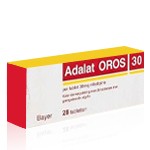Prinzmetal Angina: Understanding a Rare Form of Chest Pain


Prinzmetal angina, also known as variant angina, is a relatively uncommon heart condition that often raises confusion both among patients and even healthcare learners. Unlike the typical angina caused by blocked arteries and exertion, Prinzmetal angina is triggered by spasms of the coronary arteries. This makes it different in its cause, presentation, and management. Below we will explore what it is in simple terms, how its symptoms present, whether it falls under the definition of a heart attack type such as STEMI, the concept of the “4 E’s of angina,” and finally, the important role medications like Adalat play in treatment.
What Is Prinzmetal Angina in Simple Terms?
In the simplest language, Prinzmetal angina is chest pain that occurs when the heart’s blood vessels temporarily tighten or spasm. These spasms reduce blood flow to the heart muscle, leading to discomfort that can mimic a heart attack.
Unlike stable angina, which usually happens during exercise or emotional stress, Prinzmetal angina often strikes at rest, sometimes even during sleep. The spasm can occur in arteries that may not have significant plaque buildup, which sets it apart from the “classic” angina associated with clogged arteries.
Think of it as a sudden cramp in a blood vessel. Just like a muscle cramp can stop movement, a coronary artery spasm can briefly stop blood from flowing freely. Although temporary, these episodes can still be dangerous, especially if the spasm is prolonged.
Symptoms of Angina Spasms
The symptoms of Prinzmetal angina are very similar to those of more common types of chest pain. The key difference is in the timing and triggers. Patients often describe a sudden, squeezing pain in the chest, sometimes spreading to the arm, neck, or jaw. The pain can be severe enough to wake someone from sleep, which makes it particularly distressing.
Other symptoms that may accompany the chest discomfort include shortness of breath, sweating, nausea, or palpitations. Because the spasm temporarily reduces blood supply to the heart muscle, electrocardiograms (ECGs) taken during an episode may show alarming changes that resemble those of a heart attack. Once the spasm resolves, the ECG often returns to normal.
The unpredictability of these episodes makes the condition challenging. Whereas patients with typical exertional angina can learn to avoid or manage their triggers, those with Prinzmetal angina may experience attacks without warning, even when they are relaxed and calm.
Is Prinzmetal Angina a STEMI?
This is a common and important question. A STEMI, or ST-elevation myocardial infarction, is a type of heart attack caused by a complete blockage of a coronary artery. It results in permanent damage to the heart muscle unless treated quickly with procedures to restore blood flow.
Prinzmetal angina is not the same thing as a STEMI, but it can look very similar during an episode. On an ECG, both conditions may show ST-segment elevation, which is a classic marker of a STEMI. The difference lies in the underlying mechanism. In STEMI, the artery is blocked by a blood clot or ruptured plaque. In Prinzmetal angina, the narrowing is temporary, caused by spasm rather than a permanent blockage.
This overlap often leads to diagnostic confusion in emergency rooms. Doctors may treat Prinzmetal angina episodes aggressively at first, suspecting a heart attack, until further evaluation reveals that the artery is not persistently blocked. Importantly, if the spasm lasts long enough, it can indeed cause a real heart attack, but the condition itself should not be equated directly with STEMI.
The 4 E’s of Angina
In cardiology, doctors often refer to the “4 E’s” as common triggers of typical angina episodes. These are: Exercise, Eating, Emotion, and Exposure (usually to cold). Each of these factors can increase the heart’s demand for oxygen or cause blood vessel constriction, leading to pain in patients with coronary artery disease.
For Prinzmetal angina, the picture is somewhat different. While exertion and stress may play a role, many episodes occur without these classic triggers. In fact, Prinzmetal angina attacks are notorious for happening during rest or at night, when none of the 4 E’s are obviously at play. Still, cold exposure or strong emotional stress can occasionally contribute to spasm, so the framework of the 4 E’s remains somewhat relevant but less central compared with classic angina.
Why Prinzmetal Angina Matters
Understanding Prinzmetal angina is more than a matter of academic interest. For patients, the condition can be frightening, unpredictable, and sometimes dangerous. Even though the arteries may not be significantly clogged, the sudden spasms can cause life-threatening arrhythmias or, if prolonged, genuine heart damage.
Another reason it matters is because treatment strategies differ. Some medications that are helpful for typical angina, such as beta-blockers, may actually worsen Prinzmetal angina because they can increase the likelihood of spasm. This makes correct diagnosis crucial for proper care.
The Role of Adalat in Treatment
One of the mainstays of treating Prinzmetal angina is the use of medications that relax the coronary arteries. This is where Adalat, the brand name for nifedipine, plays an important role. Nifedipine belongs to the class of drugs called calcium channel blockers. These medicines work by preventing calcium from entering the smooth muscle cells of the blood vessels, which in turn helps the arteries stay relaxed and open.
Adalat is particularly effective in reducing the frequency and severity of angina spasms. Taken regularly, it helps prevent the episodes rather than just treating them once they occur. Some patients may be prescribed long-acting forms of nifedipine, which keep blood vessels relaxed throughout the day. In acute situations, short-acting forms may provide quick relief.
Adalat is often combined with other drugs, such as long-acting nitrates, which also help relax blood vessels. Together, these medications form the cornerstone of therapy. Importantly, drugs like beta-blockers are usually avoided because they can make spasms worse by allowing unopposed constriction of the arteries.
Like any medication, Adalat can cause side effects. Common ones include headaches, flushing, swelling in the ankles, or dizziness. However, for most patients, the benefits in reducing dangerous spasms far outweigh these drawbacks. Regular follow-up with a doctor ensures the right balance of dosage and monitoring.
Living with Prinzmetal Angina
Beyond medications, lifestyle adjustments are also important. Patients are usually advised to quit smoking, since tobacco is a strong trigger for coronary artery spasm. Avoiding exposure to very cold environments and managing stress levels can also reduce attacks. In some cases, alcohol or certain stimulants may provoke symptoms and should be minimized.
Unlike people with typical coronary artery disease, patients with Prinzmetal angina may not need procedures such as stents or bypass surgery unless they also have significant arterial blockages. Instead, medical management and careful monitoring are the main strategies.
Regular check-ups are essential, since ongoing chest pain, even from spasms, should never be ignored. If a spasm lasts unusually long or does not respond to medication, emergency care is required to rule out a true heart attack.
Prognosis and Outlook
The outlook for people with Prinzmetal angina is generally good if the condition is recognized and treated appropriately. Many patients respond well to calcium channel blockers like Adalat and can go on to live full, active lives. However, untreated or severe cases can be dangerous, particularly if the spasms lead to arrhythmias or myocardial infarction.
The key lies in awareness. Because the condition is rare, it may be overlooked at first. Patients who notice chest pain at rest, especially recurring at night, should inform their healthcare provider. Accurate diagnosis ensures that the right medications are used and harmful ones are avoided.
Conclusion
Prinzmetal angina may not be as common as other forms of chest pain, but it highlights the complexity of how the heart’s blood vessels behave. In simple terms, it is chest pain caused by spasms rather than blockages. The symptoms can mimic a heart attack, making it a condition that requires careful medical attention.
While not a STEMI itself, Prinzmetal angina can create ECG patterns that look like one, leading to understandable confusion. The 4 E’s — exercise, eating, emotion, and exposure — remain useful in discussing angina triggers, though Prinzmetal angina often breaks the rules by appearing at rest.
Perhaps most importantly, treatments like Adalat give patients a powerful tool to prevent spasms and protect the heart. When combined with lifestyle changes and medical supervision, many people with Prinzmetal angina achieve a stable and safe quality of life.
By understanding its nature, symptoms, and management, patients and doctors alike can navigate this rare but significant condition with confidence.
Drug Description Sources: U.S. National Library of Medicine, Drugs.com, WebMD, Mayo Clinic, RxList.
Reviewed and Referenced By:
Dr. Alan Carter, PharmD Clinical pharmacist with expertise in cardiovascular pharmacology. Contributor to Drugs.com and Medscape. Provides professional reviews on calcium channel blockers such as nifedipine (Adalat), with focus on pharmacokinetics, dosing, and safety in angina treatment.
Dr. Carol DerSarkissian, MD Board-certified in internal medicine and contributor to WebMD. Offers clinical validation on the diagnosis and management of angina, distinguishing Prinzmetal angina from other forms of chest pain, and ensuring patient-friendly guidance on cardiovascular health.
Dr. Dianne B. McKay, MD Professor of Clinical Pharmacology and contributor to NIH resources. Her work highlights the renal and systemic implications of long-term cardiovascular drug use, including calcium channel blockers and nitrates prescribed for Prinzmetal angina.
Dr. William C. Shiel Jr., MD, FACP, FACR Chief Editor at MedicineNet, affiliated with WebMD. Author of comprehensive content on cardiology and internal medicine, including articles on angina, myocardial infarction, and the mechanisms of coronary artery spasm.Dr. Steven Gans, MDHarvard-trained physician and reviewer for Verywell Health and WebMD. Provides expertise on the psychological impact of chronic angina and the overlap between cardiovascular symptoms and anxiety, helping validate the role of holistic care in Prinzmetal angina patients.
(Updated at Sep 25 / 2025)

